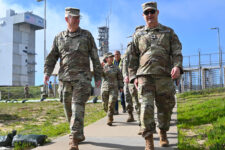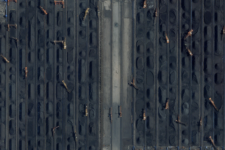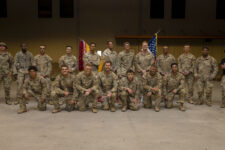
Lt. Gen. Philip Garrant, commander, Space Force Space Systems Command (left). (US Space Force photo by Senior Airman Kadielle Shaw)
AMOS 2024 — Ahead of a formal rollout in coming days, the head of Space Systems Command revealed to Breaking Defense three new “major efforts” detailed in his “action plan” — an initiative he hopes will hone the command during his time in the hotseat and beyond.
In an exclusive interview on the sidelines of the annual Advanced Maui Optical and Space Surveillance Technologies (AMOS) conference, Lt. Gen. Philip Garrant identified the three efforts as shaping the command’s structure to meet the needs program leaders, developing the workforce and reaching out to SSC’s “stakeholders,” including commercial industry and allies.
The plan, which he intends to reveal in full during SSC’s next set of “industry days” Oct. 23-24 in Los Angeles, “will absolutely cover my tenure into ’26, but it’s designed to be even a little bit more ‘future’ than that,” he said.
But the discussion was not only about the future of SCC. Garrant also weighed in on two key embattled Space Force development programs — the next-generation GPS ground system, and the ATLAS software necessary to update the service’s 1980’s-era command and control computer network for space domain awareness — citing progress on both.
Structure And Workers To Support The Buyers
While SSC is fundamentally an acquisition command, Garrant himself has no direct buying power. Instead, the purse strings are controlled by five program executive officers (PEOs) who report to the Air Force’s space acquisition head, Frank Calvelli. However, Garrant explained that he does have the responsibility for ensuring that PEOs are properly resourced and staffed.
“As the commander, I’m responsible for the quality of the work that gets delivered, because I’m responsible for the workforce,” he said.
Thus, the “first focus” of his “commander’s plan” is “making sure that we’re structured right, so that the PEOs can do their job,” Garrant said. This includes moving people around to ensure that each of the acquisition leaders are fully supported with the right types of staff.
Secondly, he intends to put energy into “workforce development” for both military and civilian personnel to ensure they are trained in how to manage acquisition programs with a keen eye on getting space capabilities to the field as quickly as possible to meet the looming threats from China and Russia. This includes “creating the culture and developing acquisition leaders” to truly take to heart the SSC motto developed by Garrant’s predecessor, Lt. Gen. Michael Guetlein: “Exploit what we have, buy what we can, and build only what we must.”
Garrant acknowledged that this is easier said than done, in particular with regard to increasing Space Force’s reliance on commercial providers by buying available products and services. The goal, he explained, is to make commercial buys “inherent in the acquisition process” by feeding those programs into the budget planning cycle upfront — “then that is success.”
“It’s really hard,” he said. “We are very comfortable in the old ways of doing business,” he said.
Transparency And Outreach
Garrant’s final focus for his tenure is “is a commitment to better connection with our … external stakeholders, an engagement and a meaningful, almost a back-to-basics approach to when we used to have agreements with the operators on ‘here’s the capability we’re going to deliver’,” he said, as well as “a commitment to be transparent.”
Part of that approach to working more closely with operators is being addressed by the Space Force’s plan to create Integrated Mission Deltas, or IMDs, that are co-led by acquisition officers under SSC and operations personnel from Space Operations Command, and have responsibility for sustainment of associated kit. The service stood up the first two last September, and is working to expand the concept to all of its mission areas. (Deltas are the Space Force equivalent of Air Force wing and group commands.)
Accompanying the IMDs, which are focused on operations, are the Integrated Systems Deltas. The latter, Garrant explained, are focused on development programs.
“You can think of a very traditional, large, Major Defense Acquisition Program,” he said, “that is still in development early in the acquisition lifecycle.” (A Major Defense Acquisition Program is a research and development program valued at more than $525 million in fiscal year 2020 dollars, or a procurement program worth more than $3.065 billion in FY20 dollars.)
In addition to SSC’s Space Force stakeholders, Garrant noted that the command also is working on outreach to allied and partner nations.
“We also recognize that there is significant value in engaging with our international partners. Our nation’s integrated deterrence strategy requires robust collaboration and information sharing with our allies,” he said in his keynote address at the AMOS conference. “International partnerships are critical to our long term SDA [space domain awareness] posture, unfortunately, allied partners were traditionally on the sidelines due to a lack of data sharing infrastructures.”
SSC is looking to fix that, he said, by creating a new “standardized interface” to the Unified Data Library (UDL), called the “Allied Exchange Environment or AXE,” designed “to facilitate near real-time two-way operational data exchange between the US and foreign allied partners.”
AXE, Garrant told Breaking Defense, will be a “technical infrastructure” that will allow allies and partners to tap into the UDL’s space monitoring database. “We’re going to expose the data to the allies, and then the allies can use the data. They can put their own tools on the data. They can ingest the data to their national databases if they want. They can contribute back,” he said.
Winter (And Progress On Ailing Programs) Is Coming
Elsewhere in the discussion, Garrant also addressed two of the Space Force’s troubled developmental programs that have been called out by Calvelli for their continued shortfalls: the GPS Next Generation Operational Control System (OCX); and the Advanced Tracking and Launch Analysis System (ATLAS) software.
OCX is needed for the Space Force to have “full control” of the jam-resistant, military-only GPS signal, as well as provide command and control of the latest model GPS satellites. Developed by RTX (formerly Raytheon), the OCX program has been a poster child for broken acquisition, having been originally planned to begin operations more than a decade ago.
But now, Garrant said, OCX now is “on track” toward “operational acceptance.”
“The site acceptance test is the last milestone for OCX acceptance by the government. We anticipate that this winter. We have had some delays since the last baseline, but frankly, those are attributable to external bases and resources, frankly, outside our control. I won’t say it’s an excuse, it’s an explanation. But we are on track to complete site acceptance tests and formally accept OCX,” he said.
ATLAS is being designed by prime contractor L3Harris as the latest Pentagon effort to replace 1970s-era Space Defense Operations Center (SPADOC) computer system for managing data from the military’s network of radar and telescopes that detect and track objects on orbit to provide space domain awareness (SDA) to operators. It too is making progress, Garrant said, after a series of delays.
“So First Lt. Garrant was working on a system to get us off of SPADOC 30 years ago,” he said, referring to the long and storied history of the failed Joint Space Operations Center (JSpOC) Mission System (JMS). (Garrant started his career as a systems engineer.)
“We anticipate doing delivery of a minimum viable product for ATLAS this winter, and go into the trial period. Presuming success out of trial period, it would be operational at the end of next year, with the intent of turning off SPADOC” Garrant said.
The Space Force originally planned the ATLAS minimum viable capability to debut in 2022.
Garrant said that one of the things the Space Force has come to realize about software-heavy command and control programs such as OCX and ATLAS is that they are used differently by operators at different levels.
“A lot of the tools we’ve been developing, we’re realizing are employed by different operational organizations at different levels of command. So, that’s a big focus for us is to make sure that we don’t have diverging tech baselines,” he said. “Or maybe we do need diverging operational baselines, but if we do, it’s deliberate and informed.”






















